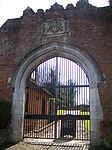The Mill Field, Hampshire
Local Nature Reserves in Hampshire

The Mill Field is a 11.7-hectare (29-acre) Local Nature Reserve in Basingstoke in Hampshire. It is owned by Basingstoke and Deane Borough Council and managed by the Mill Field Conservation Group and Basingstoke and Deane Borough Council.The field has a large area of grassland together with scrub and hedgerows. There are water voles and dormice, while insects include waved black, lunar yellow underwing and water carpet moths and marbled white butterflies.
Excerpt from the Wikipedia article The Mill Field, Hampshire (License: CC BY-SA 3.0, Authors, Images).The Mill Field, Hampshire
Bartons Lane, Basingstoke and Deane Lychpit
Geographical coordinates (GPS) Address Nearby Places Show on map
Geographical coordinates (GPS)
| Latitude | Longitude |
|---|---|
| N 51.276 ° | E -1.051 ° |
Address
Mill Field
Bartons Lane
RG24 8AN Basingstoke and Deane, Lychpit
England, United Kingdom
Open on Google Maps







